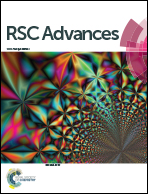Efficient removal of transition metal ions using poly(amidoxime) ligand from polymer grafted kenaf cellulose†
Abstract
A desired copolymer, cellulose-graft-polyacrylonitrile was synthesized by a free radical initiating process and optimum reaction conditions were determined for maximum grafting yield (125%). The nitrile functionalities of the grafted copolymers were converted into the amidoxime ligand by oximation reaction. The kenaf cellulose, cellulose grafted copolymer and poly(amidoxime) ligand were characterized by infrared spectroscopy, field emission scanning electron microscopy, transmission electron microscopy and X-ray photoelectron spectroscopy. The pH of the solution acts as a key factor to achieve the optical detection of metal ions using complexation of this ligand with some transition metal ions. The reflectance spectra of the [M–ligand]n+ complex was found to have a highest absorbance ranging from 97 to 99.9% at pH 6. The reflectance spectra were increased by increasing Cu2+ ion concentration and a broad peak at 700 nm was observed which indicates the charge transfer (π–π transition) complex. The adsorption capacity with copper was found to be superior; 326.6 mg g−1. The adsorption capacities for other transition metal ions were also found to be strong; Fe3+, Co3+, Mn2+, Cr3+, Ni2+ and Zn2+ were 273.6, 271.6, 241.7, 228.2, 204.2 and 224.3 mg g−1, respectively at pH 6. The experimental data of all metal ions fitted significantly with the pseudo-second-order rate equation. The data proved that the transition metal ion sorption onto ligands was well fitted with the Langmuir isotherm model (R2 > 0.99), which suggest that the cellulose-based adsorbent known as poly(amidoxime) ligand surface is homogenous and monolayer. The reusability was checked by the sorption/desorption process for seven cycles and the sorption and extraction efficiency in each cycle was determined. The new type of adsorbent can be reused in many cycles without any significant loss in its original sensing and removal performances.


 Please wait while we load your content...
Please wait while we load your content...